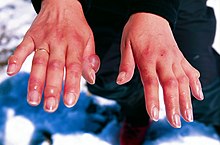| Cold injury | |
|---|---|
| Other names | Cold weather injury |
 | |
| Frostbitten fingers after descent from mountain climbing | |
| Symptoms | Numbness, skin discoloration, blisters, swelling, cold sensation[1][2] |
| Complications | Necrosis, gangrene, chronic pain, amputation[3][4] |
| Types | Freezing, nonfreezing[5] |
| Causes | Exposure to cold temperatures[6] |
| Risk factors | Military occupation, recreational winter activities, homelessness, inadequate or wet clothing, substance abuse, diabetes, peripheral vascular disease[6][7] |
| Diagnostic method | Based on symptoms[1][6] |
| Differential diagnosis | Hypothermia, Raynaud's phenomenon, chilblains (pernio), cold urticaria[8][9] |
| Prevention | Minimize cold exposure, wear protective clothing, change wet clothing, avoid substance use, maintain appropriate nutrition[1][4] |
| Treatment | Move to warm and dry environment, rewarming, medication, wound care, surgery[4][10] |
Cold injury (or cold weather injury) is damage to the body from cold exposure, including hypothermia and several skin injuries.[6] Cold-related skin injuries are categorized into freezing and nonfreezing cold injuries.[5] Freezing cold injuries involve tissue damage when exposed to temperatures below freezing (less than 0 degrees Celsius).[6][7] Nonfreezing cold injuries involve tissue damage when exposed to temperatures often between 0-15 degrees Celsius for extended periods of time.[6] While these injuries have disproportionally affected military members, recreational winter activities have also increased the risk and incidence within civilian populations.[6] Additional risk factors include homelessness, inadequate or wet clothing, alcohol abuse or tobacco abuse, and pre-existing medical conditions that impair blood flow.[6][7]
Freezing cold skin injuries include frostbite and frostnip.[8] These injuries often affect the fingers, toes, nose, and ears since they are less commonly covered by clothing when in cold environments.[1] Affected skin becomes numb, turns white or blue, and develops blisters.[1] Frostnip is a superficial skin injury that won't freeze the skin or cause long-term damage.[8] Frostbite involves freezing of fluids inside and outside of cells that results in cell breakdown, electrolyte imbalances, and inflammation.[8] Surrounding blood vessel constriction and injury disrupts blood flow to affected tissue, which may cause tissue death (necrosis).[11] Diagnosis is based on symptoms, but imaging can help assess viable tissue and risk of amputation.[6] Pre-hospital treatment involves transfer to a warm environment, changing wet clothing, and rapid rewarming with warm water if refreezing is not expected.[11] Hospital management involves rewarming, wound care, and medications to treat pain and possible blood clots.[11] Amputation of unsalvageable tissue may be required weeks to months after initial injury.[11]
Nonfreezing cold skin injuries include trench foot, a subclass of immersion foot caused by exposure to cold temperatures.[2] These injuries often affect the feet after being subjected to wet cold for several hours or days.[4] Affected individuals report a tingling or numbing sensation, red or blue discoloration, and swelling or blisters in affected skin.[2] The mechanism of injury isn't fully understood, but may involve cold-induced damage to blood vessels and nerves that results in small blood vessel (capillary) destruction, swelling, and tissue necrosis.[5] Diagnosis is based on symptoms.[2] Pre-hospital treatment includes transfer to a warm environment and exchanging wet clothing.[4] Hospital management includes gradual rewarming with air drying, elevating affected skin, and pain management.[4]
- ^ a b c d e Basit, Hajira; Wallen, Tanner J.; Dudley, Christopher (2022), "Frostbite", StatPearls, Treasure Island (FL): StatPearls Publishing, PMID 30725599, retrieved 2022-11-09
- ^ a b c d Bush, Jeffrey S.; Lofgran, Trevor; Watson, Simon (2022), "Trench Foot", StatPearls, Treasure Island (FL): StatPearls Publishing, PMID 29493986, retrieved 2022-11-09
- ^ Regli, Ivo B.; Strapazzon, Giacomo; Falla, Marika; Oberhammer, Rosmarie; Brugger, Hermann (2021). "Long-Term Sequelae of Frostbite—A Scoping Review". International Journal of Environmental Research and Public Health. 18 (18): 9655. doi:10.3390/ijerph18189655. ISSN 1660-4601. PMC 8465633. PMID 34574580.
- ^ a b c d e f Zafren, Ken (2021). "Nonfreezing Cold Injury (Trench Foot)". International Journal of Environmental Research and Public Health. 18 (19): 10482. doi:10.3390/ijerph181910482. ISSN 1660-4601. PMC 8508462. PMID 34639782.
- ^ a b c Mistry, K.; Ondhia, C.; Levell, N. J. (2020). "A review of trench foot: a disease of the past in the present". Clinical and Experimental Dermatology. 45 (1): 10–14. doi:10.1111/ced.14031. ISSN 0307-6938. PMID 31309614. S2CID 196810788.
- ^ a b c d e f g h i Heil, Kieran; Thomas, Rachel; Robertson, Greg; Porter, Anna; Milner, Robert; Wood, Alexander (2016). "Freezing and non-freezing cold weather injuries: a systematic review". British Medical Bulletin. 117 (1): 79–93. doi:10.1093/bmb/ldw001. ISSN 0007-1420. PMID 26872856.
- ^ a b c Ingram, Benjamin J.; Raymond, Tyler J. (2013). "Recognition and Treatment of Freezing and Nonfreezing Cold Injuries". Current Sports Medicine Reports. 12 (2): 125–130. doi:10.1249/JSR.0b013e3182877454. ISSN 1537-890X. PMID 23478565. S2CID 39830023.
- ^ a b c d Kowtoniuk, Robert (2021-10-01). "Cutaneous Cold Weather Injuries in the US Military". Cutis. 108 (4): 181–184. doi:10.12788/cutis.0363. PMID 34846996. S2CID 243974698.
- ^ Paal, Peter; Pasquier, Mathieu; Darocha, Tomasz; Lechner, Raimund; Kosinski, Sylweriusz; Wallner, Bernd; Zafren, Ken; Brugger, Hermann (2022-01-03). "Accidental Hypothermia: 2021 Update". International Journal of Environmental Research and Public Health. 19 (1): 501. doi:10.3390/ijerph19010501. ISSN 1660-4601. PMC 8744717. PMID 35010760.
- ^ Handford, Charles; Buxton, Pauline; Russell, Katie; Imray, Caitlin EA; McIntosh, Scott E.; Freer, Luanne; Cochran, Amalia; Imray, Christopher HE (2014-04-22). "Frostbite: a practical approach to hospital management". Extreme Physiology & Medicine. 3 (1): 7. doi:10.1186/2046-7648-3-7. ISSN 2046-7648. PMC 3994495. PMID 24764516.
- ^ a b c d Joshi, Kumud; Goyary, Danswrang; Mazumder, Bhaskar; Chattopadhyay, Pronobesh; Chakraborty, Reshmi; Bhutia, Y. D.; Karmakar, Sanjeev; Dwivedi, Sanjai Kumar (2020-10-01). "Frostbite: Current status and advancements in therapeutics". Journal of Thermal Biology. 93: 102716. doi:10.1016/j.jtherbio.2020.102716. ISSN 0306-4565. PMID 33077129. S2CID 224810280.
